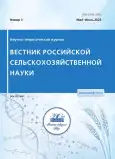Evaluation of the mechanical and biochemical composition of rare citrus taxa fruits in the Russia’s humid subtropics
- Authors: Kuleshov A.S1, Kulyan R.V1, Belous O.G1
-
Affiliations:
- Federal Research Center "Subtropical Scientific Center of the Russian Academy of Sciences"
- Issue: No 3 (2023)
- Pages: 46-52
- Section: Articles
- URL: https://journals.rcsi.science/2500-2082/article/view/147903
- DOI: https://doi.org/10.31857/2500-2082/2023/3/46-52
- EDN: https://elibrary.ru/FJJTRK
- ID: 147903
Cite item
Full Text
Abstract
Keywords
About the authors
A. S Kuleshov
Federal Research Center "Subtropical Scientific Center of the Russian Academy of Sciences"
R. V Kulyan
Federal Research Center "Subtropical Scientific Center of the Russian Academy of Sciences"
Email: raisa.kulyan22@gmail.com
O. G Belous
Federal Research Center "Subtropical Scientific Center of the Russian Academy of Sciences"
References
- Абильфазова Ю.С. Биохимические качества и механический состав плодов мандарина // Субтропическое и декоративное садоводство. 2004. №. 39(2). С. 454-464.
- Горшков В.М., Абильфазова Ю.С., Викулова Л.С. Биохимические показатели качества плодов мандарина, выращиваемых в субтропиках России в сравнении с плодами импортной продукции //Новые технологии. 2019. №.4. С. 125-135. doi: 10.24411/2072-0920-2019-10412
- Каталог цитрусовых культур. Коллекция ГНУ ВНИИЦиСК Россельхозакадемии / сост. В.М. Горшков, В.А. Фогель, Р.В. Кулян; под ред. А.В. Рындина. Сочи: ГНУ ВНИИЦиСК Россельхозакадемии, 2013. с. 91.
- Кулян Р.В., Самарина Л.С., Рахмангулов Р.С. и др. Генетические ресурсы цитрусовых культур в России, Украине и Беларуси: хранение и использование // Вавиловский журнал генетики и селекции. 2017. Т. 21. №5. С. 506-514. doi: 10.18699/VJ17.21-о
- Стандарт ЕЭК ООН FFV-14, касающийся сбыта и контроля товарного качества плодов цитрусовых, Нью-Йорк и Женева, 2017.
- FAO. Faostat: Citrus fruits, oranges, lemon, total, production quantity (tons) - for all countries. 2020. [Electronic resource]. Mode access: http://faostat.fao.org. Дата доступа 08.09.2022.
- Gorinstein S. Martı́n-Belloso O., Park Y.S. et al. Comparison of some biochemical characteristics of different citrus fruits // Food chemistry. 2001. V. 74. №. 3. P. 309-315. doi.org/10.1016/S0308-8146(01)00157-1
- Igamberdiev A.U., Eprintsev A.T. Organic acids: the pools of fixed carbon involved in redox regulation and energy balance in higher plants // Frontiers in Plant Science. 2016. V. 7. P. 1042. doi.org/10.3389/fpls.2016.01042
- Mditshwa A., Magwaza L.S., Tesfay S.Z. et al. Postharvest factors affecting vitamin C content of citrus fruits: A review // Scientia Horticulturae. 2017. V. 218. P. 95-104. doi.org/10.1016/j.scienta.2017.02.024
- Kulyan R., Belous O., Konnov N. Qualitative characteristics of collectible forms Citrus reticulata Blan. var. unchiu Tan. // BIO Web of Conferences (International Scientific and Practical Conference "Innovative Technologies in Agriculture") 2022. Vol. 47. DOI: https://doi.org/10.1051/bioconf/20224706006
- Pan T., Ali M.M., Gong J. et al. Fruit Physiology and Sugar-Acid Profile of 24 Pomelo (Citrus grandis (L.) Osbeck) Cultivars Grown in Subtropical Region of Chin // Agronomy. 2021. V. 11. №. 12. P. 2393. doi.org/10.3390/agronomy11122393
- Satari B, Karimi K. Citrus processing wastes: Environmental impacts, recent advances, and future perspectives in total valorization /Resources, Conservation and Recycling. 2018. V. 129. PP. 153-167. doi.org/10.1016/j.resconrec.2017.10.032
- Singh B., Singh J.P., Kaur A., Singh N. Phenolic composition, antioxidant potential and health benefits of citrus peel // Food Research International. 2020. V. 132. P. 109-114. doi.org/10.1016/j.foodres.2020.109114
- Tareen H., Mengal F., Masood Z. et al. Determination of Vitamin C content in Citrus Fruits and in Non-Citrus Fruits by Titrimetric method, with special reference to their nutritional importance in Human diet // Biological Forum. Research Trend. 2015. V. 7. №.2. P. 367. ISSN: 2249-3239
- Zhang J., Ritenour M.A. Sugar composition analysis of commercial citrus juice products // Proceedings of the Florida State Horticultural Society. 2016. V. 129. P. 178-180.
- Zhang S., Shi Q., Albrecht U. Comparative transcriptome analysis during early fruit development between three seedy citrus genotypes and their seedless mutants // Horticulture research. 2017. V. 4. doi.org/10.1038/hortres.2017.41
Supplementary files










